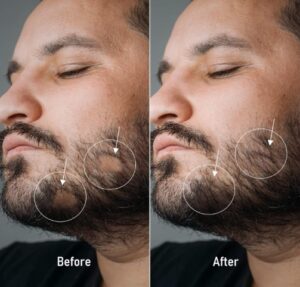Hair Supplements Biotin: Benefits, Side Effects & Oils

Something is making your hair thinner… but what? Stay with me. In a few minutes you’ll learn when biotin helps, when it doesn’t, how to avoid common mistakes (including a lab-test warning most people miss), and what to try next if biotin isn’t your answer.
Quick Take (so you don’t panic)
- Biotin (vitamin B7) supports normal hair, skin, and nails. If you’re deficient, fixing the deficiency can help hair.
- If you’re not deficient, extra biotin is not a magic switch. It can be part of a healthy routine, but it’s not a stand-alone cure.
- Hair loss has many causes (genes, hormones, stress, low iron, thyroid, meds). Biotin is only one piece of the puzzle.
Why do people link hair loss and biotin?
Severe lack of biotin can cause hair thinning. That’s why the internet loves the idea that “more biotin = more hair.” But the body doesn’t work like a video game power-up. If you already get enough biotin from food or a multivitamin, taking huge doses won’t force hair to grow faster. Think of biotin like a brick in a wall: it matters, but the wall still needs many other bricks (protein, minerals, hormones, blood flow, scalp health, low stress, and good sleep).
Who might benefit most from biotin?
- People with poor intake or malabsorption: very restrictive diets, heavy alcohol use, long-term antibiotics, certain gut issues.
- People with high raw egg white intake: raw whites have avidin, a protein that binds biotin (cooking solves this).
- People whose multivitamin is missing B-vitamins: a well-rounded multi often covers basic needs, including biotin.
If you suspect deficiency, talk to a healthcare professional. Don’t self-diagnose—other problems (like low iron or thyroid issues) can mimic “biotin problems.”
Which biotin vitamin is best for hair growth?

hair biotin supplement
Users often search: which biotin vitamin is best for hair growth. Here’s the simple answer:
- Form: Most brands use d-biotin. It’s the active form your body uses. Tablet or capsule is fine. Liquid and gummies are okay too—pick what you’ll take consistently.
- Dose: Many hair products push mega-doses (5,000–10,000 mcg). For most people, a standard daily amount (like what you find in a multivitamin) is enough to cover needs. Bigger isn’t always better; consistency and a full routine matter more.
- Quality: Choose reputable brands with third-party testing and clear labels. Avoid mystery blends that hide the actual microgram amount.
How to use biotin the smart way
- Start simple: If you already take a multivitamin, check if it has biotin. You might not need a separate pill.
- Be consistent for 90 days: Hair cycles are slow. Realistic reviews wait 3–4 months.
- Track one change at a time: If you add five products at once, you won’t know what worked.
- Pair with the basics: Enough protein, iron-rich foods, omega-3s, restful sleep, gentle scalp care, and stress control.
Biotin for hair side effects (read this carefully)
Biotin is water-soluble and generally well tolerated. But there are two key notes:
- Lab tests: High biotin intake can interfere with some blood tests (for example, certain thyroid or heart tests that use biotin-based methods). Tell your doctor you take biotin. They may ask you to pause it before labs.
- Skin: A few people report breakouts when jumping to mega-doses. If this happens, reduce the dose or stop and see if your skin clears.
If you’re pregnant, nursing, or managing a health condition, ask your clinician before starting any supplement.
What about hair oils with biotin?
There’s a lot of interest in hair biotin oil, biotin hair growth oil, and hair oil with biotin. Here’s how to think about them:
- Biotin is a vitamin, not a growth hormone. Applied on top of the scalp, it’s mainly a conditioning add-on. It may support the scalp barrier and hair shaft feel when combined with nourishing oils.
- The base oil matters: Lightweight options (like jojoba or argan) can moisturize without heavy buildup. Heavier oils (like castor) can feel thicker—some people love them, some don’t.
- Scalp comfort first: If your scalp gets itchy or flaky, less is more. Try a tiny amount and wash as needed.
How to use biotin hair oil in a routine
- Night before wash: Massage a few drops into the scalp for 2–5 minutes to boost circulation (gentle pressure only).
- Mid-lengths and ends: Smooth a drop or two to reduce frizz and improve shine.
- Clarify once a week: Use a mild clarifying shampoo if you notice buildup or flat roots.
A complete beginner routine (easy and realistic)
Below is a simple plan you can follow for 12 weeks. Keep a quick photo diary every Sunday in the same lighting to track changes.
Morning
- Nutrition base: Protein at breakfast (eggs, Greek yogurt, tofu, or a protein shake).
- Multivitamin: One daily that includes biotin plus essentials like iron (if you need it), vitamin D, zinc, and B12. (Ask your clinician if you have a condition or take meds.)
- Hydration: Aim for steady water intake during the day.
Evening
- Scalp care 2–3×/week: Gentle massage with a few drops of biotin hair oil or a lightweight scalp serum. No harsh scratching.
- Wash routine: Cleanse when the scalp feels oily or itchy. Choose a gentle shampoo; avoid very hot water.
Weekly
- Clarify or exfoliate: If you use oils, clarify once a week. If your scalp is sensitive, every other week.
- Stress check-in: A 10-minute walk, breathwork, or stretching. It matters more than you think.
Common mistakes to avoid
- Only taking biotin and ignoring the basics: Food, sleep, and stress are the “big levers.”
- Expecting results in 2 weeks: Hair cycles take time. Review at 12 weeks, not 12 days.
- Using too much oil on the scalp: Buildup can make hair look flat and clog the feeling. Less is more.
- Skipping medical checks: If you’re shedding fast or have patchy loss, talk to a professional. You may need labs (iron, thyroid), meds, or a different plan.
FAQ for first-time readers
Does biotin really grow hair?
It helps if you were low in biotin to start with. If not, think of it as a small helper—not a solo solution. Use it alongside nutrition, scalp care, and, when needed, medical support.
How much biotin should I take?
Many people do well using the amount in a daily multivitamin. Mega-doses are popular online, but they aren’t always necessary. Talk to your clinician if you’re unsure.
How long until I see changes?
Give any routine 3–4 months. Track with photos in the same light, same angle.
Can I just use biotin hair growth oil instead of a supplement?
Topical products can help your hair feel better and your scalp feel comfortable. But nutrition still matters. Oils are “outside-in”; supplements and food are “inside-out.” Both sides help.
Are there side effects?
Biotin is usually well tolerated, but very high doses can affect some blood tests and may trigger breakouts in a few people. Always tell your doctor if you take biotin.
If biotin isn’t enough, what else should I know?
Hair loss isn’t one single problem. Here are other areas to check with a professional:
- Iron and ferritin: Low stores can contribute to shedding, especially in women.
- Thyroid function: Both low and high thyroid activity can affect hair.
- Androgen sensitivity (pattern hair loss): Very common and treatable—often with topical or oral options prescribed by a dermatologist.
- Stress and sleep: Big stress can push more hairs into a shedding phase (telogen effluvium). It usually improves once stress eases and the routine supports growth.
How to pick products without wasting money
- Check the label: Clear biotin amount (in micrograms), plus other nutrients you need. Avoid huge “proprietary blends” without details.
- Look for synergy, not clutter: Biotin pairs well with a balanced multi, protein-rich diet, and gentle scalp care. You don’t need ten different bottles.
- Patch test topicals: Try new oils or serums on a small area first, especially if you have a sensitive scalp.
Sample 12-Week Starter Plan (you can copy this)
Weeks 1–4: Begin or confirm a multivitamin with biotin. Take daily with food. Start twice-weekly gentle scalp massage (2–5 minutes) using a light biotin hair oil. Wash as needed to avoid buildup. Eat protein at each meal.
Weeks 5–8: Keep the routine. Add a weekly clarify if you use oils. Take progress photos each Sunday. Note any changes in shedding, scalp comfort, or hair feel.
Weeks 9–12: Review photos and notes. If shedding stays high or you see patchy loss, book a check-in with a clinician to explore iron, thyroid, or other causes.
“Hair supplements biotin” — putting it all together
Biotin can support healthy hair as part of a complete plan. On its own, it’s not a magic cure—but used wisely, with simple nutrition and scalp habits, it can help your routine feel structured and calm, not chaotic.
Before you go (the loop we opened at the start)
You wanted to know if biotin is your missing piece. Now you know how to use it safely, how to spot side effects, and how to build a routine that works from the inside out and the outside in. Your next step is easy: pick one action today—check your current multivitamin, plan this week’s protein, or schedule a quick scalp massage night. Small steps, repeated, turn into visible change.
Key Takeaways & Next Steps
- Start with the basics: food, sleep, stress, gentle scalp care.
- Use biotin smartly: a balanced multi may be enough; mega-doses aren’t always needed.
- Watch for lab-test interference: tell your doctor you take biotin.
- Give it time: review progress at 12 weeks with photos.
- Ask for help if needed: if shedding is fast or patchy, get professional guidance.
Related Searches Covered
- which biotin vitamin is best for hair growth: choose a clear-label, quality brand; consistent routine matters most.
- biotin for hair side effects: possible lab-test interference and rare breakouts at high doses.
- hair biotin oil / biotin hair growth oil / hair oil with biotin: treat as conditioning scalp care; the base oil and gentle use matter more than “biotin” on the label.


